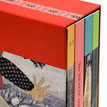| Francis M. Naumann |
Florine Stettheimer's Hand-Painted
China Plates |
Both the style and subject matter of these plates would indicate that
they
were made fairly early in Stettheimer’s career. Because they were
painted
on the facing side of rare and fairly expensive gold-edged Bavarian china,
it is likely that they were made in the years when the artist lived and
worked in Germany. She occupied a studio in Munich in 1913, but when
war broke out in the fall of 1914, she and her entire family moved to New
York. If this supposition is correct, and the plates were painted in this
early period, then the style they employ––an intentionally
naïve yet
simultaneously sophisticated manner of painting (particularly evident in
the figures depicted on the two smaller plates)––could very
well represent
the first appearance of an approach to painting that, in years to come,
Stettheimer would embrace and refine, so much so that it would eventually
become the hallmark of her mature style.
Since the two smaller plates are marked with a diamond (Plate A) and
spade (Plate C), it is logical to assume that Stettheimer may have made
two
other plates bearing symbols of hearts and clubs, thereby completing the
four suits in a card set. If made, these other plates are yet to be recovered.
Whatever their intention, it is difficult to relate card-playing symbols
with the subject depicted on the central plate: a magnificent oversized
red
rose covers the body of a recumbent female nude. Behind the head of this
figure can be seen an unopened rose bud, contributing to a screen of foliage
that covers the figure of a naked boy who seems to be running off into
the
far background. Given the other elements in this composition, we could
speculate that this boy represents Cupid. He does not brandish an arrow,
however, but, quite curiously, carries on his back a large wooden crucifix.
How such a potent religious symbol figures in the iconography of this
image is revealed on the verso of the plate, where Stettheimer has attached
a sheet of paper on which appears one of her typewritten poems:
Dear Critic
:-
This awkward (?) “position” of
my “Love”—is
like a
petition,
to Zeus above.
You wonder why thus
twisted her limbs and torso?
‘’cause
she hates the cross, the
“boy” wears ‘addosso’ —,
like Adonis: at play
he chided Venus—
off ’ring herself, ‘ganzlich
ent-/kleided.’
Und was die Kunst
angelangt, mir vor
Vergleichen
mil Grossen nicht/bangt.-
Seht Tizian’s
Raub der Europa an :
da
ist ein Englein, verdreht im/wahn.
F. St.¹
1. Translation:
‘completely un- / dressed.’
And, as far as art is concerned, I am not
worried about comparison with the great.-
Look at Titian’s Rape of Europa:
there is a little angel, twisted around in madness.
F. St.
—
FRANCIS M. NAUMANN is an independent scholar, curator, and art dealer,
specializing
in the art of the Dada and Surrealist periods. He is author of numerous
articles and exhibition catalogues, including New
York Dada 1915-25 (Harry
N.
Abrams, 1994), Marcel Duchamp: The Art of Making
Art in the Age of Mechanical Reproduction (Harry N. Abrams, 1999), Wallace
Putnam (Harry N. Abrams,
2002) and, most recently, Conversion to Modernism:
The Early Work of Man Ray (Rutgers University Press, 2002). In 1996, he organized Making
Mischief: Dada
Invades New York for the Whitney Museum of American Art, and in 1997,
Beatrice
Wood: A Centennial Tribute for the American Craft Museum in New York.
He
is preparing for publication a selection of his essays on Marcel Duchamp,
and he
currently owns and operates his own gallery in New York City.
For the complete article purchase The Sienese Shredder #2
Also by Francis M. Naumann
A Problem with No Solution
Back to The Sienese Shredder #2
| 

